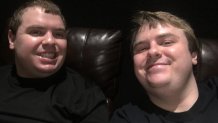April is Autism Awareness Month. A new study is shedding light on autism spectrum disorder.
Autism, or autism spectrum disorder (ASD), refers to a broad range of conditions characterized by challenges with social skills, repetitive behaviors, speech and nonverbal communication.
According to the U.S. Centers for Disease Control and Prevention, 1 in every 36 8-year-old children across the United States has been identified as having autism spectrum disorder.
The findings come from the CDC’s Autism and Developmental Disabilities Monitoring (ADDM) Network. The ADDM Network has been collecting and reporting ASD data from across the United States for more than 20 years. Click here to read more.
Get DFW local news, weather forecasts and entertainment stories to your inbox. Sign up for NBC DFW newsletters.
Data collected by the ADDM Network in 2020 show that ASD continues to increase over previous years’ numbers. The 1 in 36 statistic is based on tracking in 11 communities across the United States. This number is higher than the ADDM Network’s 2018 estimates, which found that 1 in 44 8-year-old children was identified with ASD.
"Here in the U.S., what stands out and that kind of separates this data from prior research is that historically, it's been the culturally and linguistically diverse families that have been marginalized from the ASD diagnosis,” said Dr. Lee Mason, an applied behavior analyst for Cook Children's Child Study Center. "The big difference with the numbers that we're seeing now are that Hispanic and African American rates are increasing faster these days.”
For the first time, ADDM data found that the percentage of 8-year-old Black (2.9%), Hispanic (3.2%), and Asian or Pacific Islander (3.3%) children with ASD was higher compared with 8-year-old white children (2.4%). This is the opposite of racial and ethnic differences observed in previous ADDM reports.
Local
The latest news from around North Texas.
Mason said that could be because of better awareness and access to screenings.
"As services are becoming more available to a more diverse group of individuals, we're seeing a more representative number of diagnoses,” he said.
Signs of autism usually appear by age 2 or 3. Some associated development delays can appear even earlier, and often, they can be diagnosed as early as 18 months. Research shows that early intervention leads to positive outcomes later in life for people with autism.
“The faster we can get them into early intensive behavioral intervention, the better the outcomes for children with ASD,” said Mason. "The numbers show that we can reliably diagnose as young as two years of age. Intervening at that age is certainly critical but the majority of diagnoses aren't occurring until the age of four. So we still have some room to improve."
Click here for more information on screenings and resources through Cook Children's Child Study Center.
LIVES FOREVER CHANGED
Trent Lundgren is a voice for many who cannot express what it’s like to be on the spectrum.
“It was a bit stressful, just because I kind of felt like the odd kid out,” he said of his childhood. “To see how far I’ve come – I never would have pictured this at all.”
Trent was diagnosed with high-functioning ASD when he was a child. His mother, Kate Lundgren, said Trent was actually screened when the family lived in California but nothing came of it.
“We were told that he’s just a boy and that he took longer to develop,” she recalled.
Boys traditionally tend to acquire language a little bit slower than girls, which can delay a proper ASD diagnosis. Data also shows boys are four times more likely than girls to have an ASD diagnosis.
Kate said she got an official diagnosis from doctors once the family moved to Texas. However, resources were hard to come by, especially in the early 1990s.
“It was a different world then. You felt very much like you were on an island,” she said.

Kate and her husband, Joe, raised not only Trent but his younger brother, Spencer, who was diagnosed with a more severe form of autism, specifically pervasive developmental disorder-not otherwise specified (PDD-NOS).
“He didn’t have language until he was about 6,” Kate said. “He now can argue with me and tell me to leave him alone at [age] 27 and he wants to go take a nap.”
About 40% of children with autism are non-verbal. About 25%–30% of children with autism have some words at 12 to 18 months of age and then lose them. Others might speak, but not until later in childhood.
Kate said enrolling her sons in different types of therapy ultimately transformed the family’s journey with ASD.
“My boys' lives have been changed,” said Kate.
She remembers how much she had to drive just to find locations that offered the speech, social skills and other therapies that helped her boys.
“I drove all over Dallas-Fort Worth because there weren’t centers around here. I was down in downtown Dallas – sometimes I was over closer to DFW, having to find the services that I needed for them,” she said. “My husband used to say, there are soccer moms – my wife is a therapy mom.”
The lack of resources led the Lundgrens to open their own clinic to provide help for other families. In 2013, they opened Cutting Edge Pediatric & Adult Therapy (CEPT), an occupational, speech, physical and ABA therapy clinic which opened in Allen. The clinic specializes in children with special needs, spectrum-related disorders and sensory integration dysfunction.

It’s a one-stop shop for families to get the help they need with various classes, therapists, a staff of over 80 people at two locations and even an in-house coffee shop where clients can work to practice on social skills.
CEPT serves families with babies to 30-year-old adults. After that, clients can continue services on a case-by-case basis.
“I tell parents – and I come across so many parents – it is not a sprint, it is a journey. A long journey,” said Kate.
Now as a high-functioning adult at age 30, Trent has a job, his own apartment, a girlfriend, and more hope than he’s ever felt in his life.
“Because we had so many people tell us it’s just not possible,” he said. “I’m a manager at a theater and I have several employees that are autistic, and some of them are higher functioning like me. So I’m like, OK, maybe I’m not as out of place as I thought.”
It’s a reminder that autism varies from person to person and no two people with autism are alike.

Trent said he’s not just proud of himself. He mostly credits his parents.
“I’m actually more proud of them because I can’t imagine how are hard it was. I remember the struggles they went through. I remember the sleepless nights the stress they would go through,” he said. “I owe them the world and more. I owe everything to them.”
Like many adults with ASD, Trent still continues his therapies. He is also working to help the world to see autism in a different light.
“Stop looking at autism as a disadvantage or disability. It could literally be an advantage as well,” he said. "We just see the world differently and experience things differently. And sometimes in very unique ways.”



